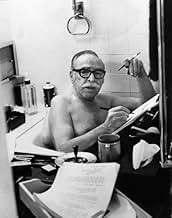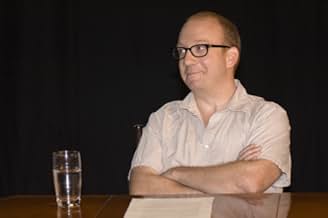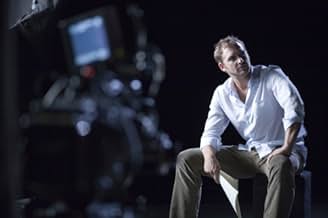Agrega una trama en tu idiomaThrough a focus on the life of Dalton Trumbo (1905-1976), this film examines the effects on individuals and families of a congressional pursuit of Hollywood Communists after World War II. Tr... Leer todoThrough a focus on the life of Dalton Trumbo (1905-1976), this film examines the effects on individuals and families of a congressional pursuit of Hollywood Communists after World War II. Trumbo was one of several writers, directors, and actors who invoked the First Amendment in ... Leer todoThrough a focus on the life of Dalton Trumbo (1905-1976), this film examines the effects on individuals and families of a congressional pursuit of Hollywood Communists after World War II. Trumbo was one of several writers, directors, and actors who invoked the First Amendment in refusing to answer questions under oath. They were blacklisted and imprisoned. We follow T... Leer todo
- Premios
- 1 premio ganado en total
- Self
- (material de archivo)
Opiniones destacadas
We have insights from Donald Sutherland; we also have Michael Douglas, Nathan Lane, Brian Dennehy and Liam Neeson reading letters in their smooth, rich voices. What a great way to welcome audiences to the story of political persecution.
Trumbo himself says that "people joined the Communist Party because they felt it was doing something". He never really comes out and embraces Communism, but the whole era was a mess -- America allied with the Russians in World War II, and once the Nazis were defeated, anyone with Communist sympathies was tossed aside.
This film also has great archive footage of Walt Disney and others.
What a story, told mostly by Trumo himself through his letters, segment of his book "Johnny Got His Gun," and interviews he gave. The letters and book portion are read by a wonderful cast: Michael Douglas, Josh Lucas, Nathan Lane, Paul Giametti, Diane Lane, David Strathairn, Brian Dennehy, Liam Neeson, and Donald Sutherland.
There are also interviews with his children, Mitzi and Christopher, Walter Bernstein, Otto Preminger, Kirk Douglas, Dustin Hoffman, Kate Lardner, and others.
We're shown a brilliant man who is an equally brilliant screenwriter. His career is stopped thanks to the blacklist, because he refused to answer "are you now or have you ever been a member of the Communist party?" - not taking the fifth amendment which would protect him from self-incrimination, but, like the rest of the "Hollywood Ten," the first amendment where the government is prohibited from inhibiting free association, and their right to silence.
Trumbo liked a good fight, and he stuck to his beliefs, even though it meant going broke, having to move to Mexico, and ultimately writing 18 screenplays under other names or being uncredited.
It wasn't until the late '50s, when some producers began hiring blacklisted people and 1960, when Otto Preminger and Kirk Douglas broke the blacklist by crediting Trumbo for their films, that the blacklist began to lose its sting. It would take others much longer to regain their reputations, if they ever did. Many lives were ruined in its wake.
This is such a compelling documentary, but if you weren't around in that era, it probably won't have the impact it did on someone like me. When I was growing up, the most terrifying thing in the world was Communism.
In truth, it was a philosophy that sounded good to people during the depression. Philosophies on paper always sound good - unfortunately they don't work when you have human beings involved. Most people became disillusioned with it and, after attending some meetings or even joining, gave it up.
Sadly, if. like Lee Grant, you even went to the funeral of someone who was suspected of being a communist, you were blacklisted.
As Trumbo put it, the Elks were probably as influential in the end. But J. Edgar, McCarthy, and others saw Communists under every chair. It was a furor that caused a lot of damage and denied us the work of some great artists.
Highly recommended for an excellent look at what was going on during that time.
It keeps the audience interested by contributions from different actors reading Trumbo's letters, letters and writings he wrote before, during and after the dark era of blacklisting, and when he spent time in prison for not "naming names" to the Senate subcommittee.
Brian Dennehy, Michael Douglas, Paul Giamatti, Josh Lucas, Nathan Lane and others are interspersed with actual interviews with Dalton Trumbo, his friends, and his family members including his loyal wife and children.
Trumbo wrote "Johnny Got his Gun" which was a commentary on the futility and human costs of war. The book actually was banned for a time in the U.S. It is important for students to learn of these censorship issues, which can and do exist, even in our country. The run time is not overly long for a documentary. Highly recommended. 10/10.
At a time when terms like "patriot" are increasingly misused, abused and bastardized, the story of writer, Dalton Trumbo, and others like him who suffered grave injustices in the hands of their own fellow countrymen, needs to be heard far & wide and esp. by the young in this country.
I wished they would add this film & others like it to every high-school history-class curriculum, as they are just as relevant today. An immensely moving and heartbreaking story & an absolute must-see (be sure to read the closing credits.)
~NN
¿Sabías que…?
- TriviaThe film was inspired by "Trumbo: Red, White and Blacklisted," a play compiled from Dalton Trumbo's letters by his son, Christopher Trumbo. The play opened off-Broadway in 2003, with Nathan Lane, also in the film, as Trumbo and directed by Peter Askin, who directed the film. One of the actors who stepped in was Brian Dennehy, also in the film, who then toured the show nationally.
- ConexionesFeatures La princesa que quería vivir (1953)
Selecciones populares
- How long is Trumbo?Con tecnología de Alexa
Detalles
Taquilla
- Total en EE. UU. y Canadá
- USD 109,057
- Fin de semana de estreno en EE. UU. y Canadá
- USD 28,125
- 29 jun 2008
- Total a nivel mundial
- USD 109,057
- Tiempo de ejecución1 hora 36 minutos
- Color
- Mezcla de sonido
- Relación de aspecto
- 1.85 : 1
Contribuir a esta página





































